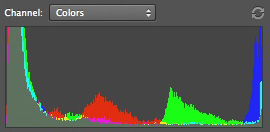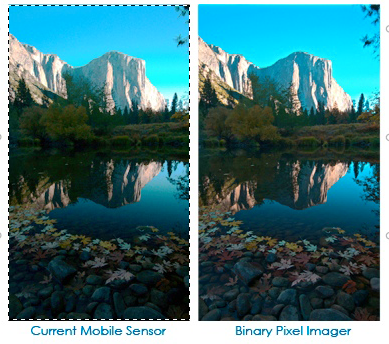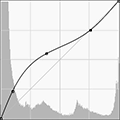Photo Corners headlinesarchivemikepasini.com
![]()
A S C R A P B O O K O F S O L U T I O N S F O R T H E P H O T O G R A P H E R
![]()
Reviews of photography products that enhance the enjoyment of taking pictures. Published frequently but irregularly.
Rambus Binary Pixel: What About Highlights?


27 February 2013
Rambus has announced a new sensor designed to expand the range of tones a small sensor device can capture in a single shot.
The problem is well-known to all photographers, not just smartphone shooters and not just digital photographers. No medium can capture the full range of tones that the human eye can see.

Smartphone Sensor

Binary Pixel Imager
Smaller sensors typically have more severe problems at both ends of the tonal range, though. Shadow detail is lost and highlights are clipped to white. And there has been a stampede to improve smartphone image quality.
Rambus claims its technology is "optimized at the pixel level to sense light similar to the human eye while maintaining comparable form factor, cost and power of today's mobile and consumer imagers."
But "light similar to the human eye" covers a lot of ground, particularly in the "bright landscapes, sunset portraits and scenes with both sunlight and shadow" that Rambus targets for improvement.

Smartphone Histogram

Binary Pixel Histogram
On its Web site, the company displays a typical smartphone image alongside an image captured with its binary pixel imager as a proof of concept.
While the two images, reproduced here, do show significant more detail in the shadows, we were surprised to see clipped highlights in the improved image. To confirm what our eyes told us, we opened the images in Photoshop CS6 and examined the histograms.
And, in fact, the blue channel shows clipped highlights.
Is the improvement of the Rambus imager then, essentially, the equivalent of a bit more exposure?
Well, not quite. We used Curves to adjust the mobile sensor capture to closely match the Rabus imager capture. We had to hold highlights on the curve as we lightened both the midtones and, even more, the shadows.


Our Curves Adjustment to Sensor Image
Equivalents. We selected the sensor image and used Photoshop's Curves command to come up with a quick equivalent to show what the Rambus imager is doing.
That speaks well for the imager's low-light performance and does, at the same time, improve dynamic range with more shadow detail. But it does nothing for highlight detail.
The company did not respond to our request for comment.
Rambus Unveils Binary Pixel Technology that Dramatically Improves Photo Quality in Mobile Devices
Breakthrough Technology Provides Single-Shot High Dynamic Range and Improved Low-Light Sensitivity in a Single Exposure
SUNNYVALE, Calif. and BARCELONA, Spain -- Rambus Inc., the innovative technology solutions company that brings invention to market, has unveiled breakthrough binary pixel technology that dramatically improves the quality of photos taken from mobile devices. The Rambus binary pixel technlogy includes image sensor and image processing architectures with single-shot high dynamic range and improved low-light sensitivity for better videos and photos in any lighting condition.
"Today's compact mainstream sensors are only able to capture a fraction of what the human eye can see," said Dr. Martin Scott, chief technology officer at Rambus. "Our breakthrough binary pixel technology enables a tremendous performance improvement for compact imagers capable of ultra high-quality photos and videos from mobile devices."
As improvements are made in resolution and responsiveness, more and more consumers are using the camera functionality on their smart phone as the primary method for taking photos and capturing memories. However, high contrast scenes typical in daily life, such as bright landscapes, sunset portraits and scenes with both sunlight and shadow, are difficult to capture with today's compact mobile sensors -- the range of bright and dark details in these scenes simply exceeds the limited dynamic range of mainstream CMOS imagers.
This binary pixel technology is optimized at the pixel level to sense light similar to the human eye while maintaining comparable form factor, cost and power of today's mobile and consumer imagers. The results are professional-quality images and videos from mobile devices that capture the full gamut of details in dark and bright intensities.
Benefits of binary pixel technology:
- Improved image quality optimized at the pixel level
- Single-shot HDR photo and video capture operates at high-speed frame-rates
- Improved signal-to-noise performance in low-light conditions
- Extended dynamic range through variable temporal and spatial oversampling
- Silicon-proven technology for mobile form factors
- Easily integratable into existing SoC architectures
- Compatible with current CMOS image sensor process technology
The Rambus binary pixel has been demonstrated in a proof-of-concept test-chip and the technology is currently available for integration into future mobile and consumer image sensors. For additional information visit http://www.rambus.com/binarypixel.